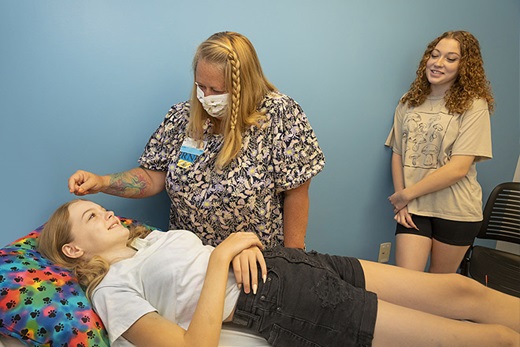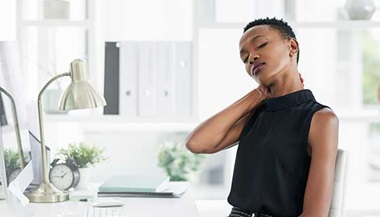Patient Story
Amplified Muscular Skeletal Pain Syndrome: Kaylie and Averie's Story
Patient Story Highlights
- For children with chronic pain and other conditions, acupuncture is a safe, natural method of treating pain.
- Sisters Kaylie and Avery suffer from a condition called amplified muscular skeletal pain syndrome (AMPS).
- Johns Hopkins all Children's Hospital Pediatric Acupuncture Clinic provides cumulative healing effects for children with chronic pain.

Mellisa was desperate. She hated seeing her young daughters, Kaylie, 14, and Averie, 12, in constant pain. They both suffer from a condition called amplified muscular skeletal pain syndrome (AMPS) that causes extreme pain all over their body.
It’s a hereditary disease that causes the body to overreact to everything. The pain is constant. It also causes severe migraine headaches and insomnia.
Mellisa had tried everything to give her daughters some comfort from the pain. But a visit to the pain clinic at the Johns Hopkins All Children’s Hospital in St. Petersburg, Florida, changed everything. That’s where she learned that acupuncture was available for children.
“We’ve tried everything else, so I thought, let’s take a chance.”
“I’ve had acupuncture in the past and it helped me so much. We had looked for an acupuncture clinic that treated kids where we live in Naples, Florida, but couldn’t find any,” she says. “While it was quite a distance for us to go all the way to St. Pete, I was willing to try anything to make my girls feel better.”
Known as a viable form of treatment for adults, acupuncture for children is not as common or available. This proven ancient Chinese medical technique for relieving pain, curing disease and improving general health has been used dating to 2500 BC.
“Acupuncture works by gently influencing all the body’s systems to function properly, restoring balance in the body,” says Kym Householder, MSOM, B.S.N., LAc, R.N., coordinator for the Chronic Pain Management Program and a licensed acupuncturist at Johns Hopkins All Children’s.
“If we are perfectly balanced, and the scientific word for that is homeostasis, which is the state the body is constantly trying to achieve, then we won’t have symptoms of disease, or pain, or illness.
“Acupuncture points were discovered thousands of years ago, but we now know they are located in strategic locations near nerves, blood vessels and muscles that when activated by the acupuncture needles, stimulate the brain to heal the body. There are nearly 400 acupuncture points located all over the body,” she says.
Activating these points, located on meridians (or channels, or pathways), which flow all over the body, stimulates all your body’s systems to function the way they are supposed to — restoring balance — bringing the body back into homeostasis.
Acupuncture helps many things other than pain, such as depression and anxiety, ADHD, gastrointestinal disorders, allergies, asthma and more.
“The acupuncture treatments are working well, and the girls really seem to have their quality of life back,” Mellisa says. “They don’t seem as tired and don’t complain as much about their body pain. The migraines are less common, and they are both sleeping better.”
But, Householder admits, “most kids are apprehensive at first because they don’t like needles. So, we don’t always have to use needles. There are many other ways to stimulate the acupuncture points.”
“Acupuncturists have many tools in their toolbox,” she says. “They might use ear seeds, which are a form of auriculotherapy, which uses acupressure points in the ear to stimulate other parts of the body. They also use a point stimulator that uses a tiny electrical current that isn’t painful. I do cupping, which is an alternative therapy that uses suction cups to stimulate your skin and muscles. The suction promotes increased blood circulation, which may help relieve muscle tension, promote cell repair, and aids in other regeneration. I’m trained to do Chinese medical massage and a special kind of pediatric massage called Shonishin. All of these massage techniques focus on stimulating the acupuncture points."
“My approach is to not only treat the symptoms, but to determine the root cause of the problem,” Householder says. “I ask a lot of questions that helps me identify the pattern that is causing the problem. Once I identify that pattern I come up with my treatment plan. And it’s different for everyone. It’s very specialized and customized care."
An acupuncture treatment plan is usually once a week for four to six weeks, then every other week, then once a month. Some patients come on a monthly basis for maintenance. All treatment plans vary depending on the patient.
“As a mom, I don’t want to put the girls on medication if I don’t have to,” Mellisa says. “So anytime we can supplement their treatment with something that is more natural that won’t impact them negatively, that’s always good. I am super grateful that acupuncture is available for my girls. I’m excited to see where the medical field takes us.”
The girls credit the acupuncture treatments and the care they are receiving from Householder for their pain relief. “Miss Kym helped the aches on my body go away. She made me relax, and she is easy to talk to,” Averie says.
“Since I started acupuncture, I have stopped having headaches,” Kaylie says. “Acupuncture has helped me a lot. It’s something kids should not be scared to try.”
Kaylie and Averie's Acupuncturist
Kym Householder, MSOM, B.S.N., LAc, R.N.
.jpg?h=100&iar=0&w=80&hash=D2771D8C3DD6C342CC5C86F3BF4739A4)




